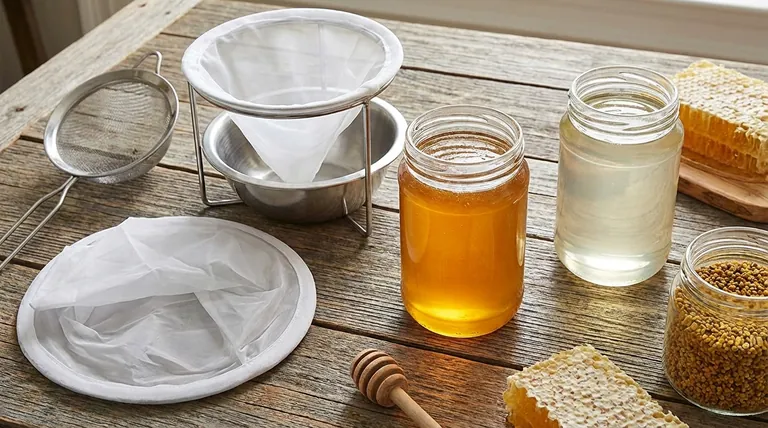To remove virtually all pollen from honey, you must use a filter with a mesh size smaller than an individual pollen grain. Since pollen particles typically range from 25 to 150 microns, a filter rated under 25 microns is required to ensure complete removal. This process is often referred to as ultrafiltration.
The question isn't simply what size filter removes pollen, but whether you should remove it. Standard filtration aims to remove debris while preserving pollen, as pollen is essential to the honey's identity, flavor, and classification.

Understanding Pollen and Filter Sizing
To make an informed choice, you must first understand the relationship between micron size, pollen, and other solids found in raw honey.
The Size of a Pollen Grain
Individual pollen grains are microscopic, generally falling within a 25 to 150-micron range. For scale, a typical human hair is about 70 microns in diameter.
While bees collect individual grains, these particles often clump together in the hive. This means some pollen may be caught by coarser filters, but individual grains will always pass through.
The Goal of Standard Filtration
Most beekeepers use filters with a much larger mesh size, typically between 200 and 600 microns.
The purpose of this level of filtration is not to remove pollen. Instead, it is designed to strain out larger impurities like bits of beeswax, wood from the hive, and other debris, resulting in a cleaner product.
The Threshold for "Ultrafiltration"
To remove what is defined as "substantially all" pollen, the honey must be forced through a filter finer than 25 microns.
This process, known as ultrafiltration, fundamentally changes the nature of the honey. It is no longer considered "raw" and, in some jurisdictions, may not even be classifiable as honey from a specific floral source without its pollen fingerprint.
The Critical Trade-offs of Fine Filtration
Choosing your filter size is a decision between clarity and character. Each approach has significant consequences for your final product.
Pro: Visual Clarity and Shelf Stability
The primary reason for ultrafiltration is to create a perfectly clear, liquid honey that appeals to some mass-market consumers.
Removing all suspended particles, including pollen, can also slow the natural process of crystallization, keeping the honey liquid on the shelf for longer.
Con: Loss of Terroir and Identity
Pollen is the key to honey's "terroir"—its unique taste, aroma, and color derived from a specific time and place. Removing it strips the honey of its floral origin story.
Many consumers of raw and artisanal honey specifically seek out these unique characteristics and view pollen as a valuable component, not a contaminant.
Con: The "Filtered Honey" Classification
Honey that has been ultrafiltered to remove pollen may be labeled as "filtered honey." This can be perceived negatively by educated consumers and may not qualify for premium pricing.
For honey to be certified as a single-floral variety (like Tupelo or Orange Blossom), it must contain the requisite pollen to prove its origin. Ultrafiltration makes this verification impossible.
Choosing the Right Filter for Your Goal
Your filtration strategy should be a direct reflection of the product you intend to create.
- If your primary focus is raw, artisanal, or "cream of the crop" honey: Use a coarse filter (400-600 microns). This removes large debris while preserving the pollen and all the natural character of the honey.
- If your primary focus is a standard, clean honey for local markets: A double-filter system is effective. Start with a 600-micron filter to catch large particles, then pass it through a 200-micron filter for a polished result that retains its pollen.
- If your primary focus is mass-market appeal and maximum shelf stability: You must use an ultrafiltration system (under 25 microns). Be aware that this removes pollen and fundamentally alters the product away from its raw state.
Ultimately, your choice of filter defines the integrity and identity of your honey.
Summary Table:
| Filter Micron Size | Purpose | Resulting Honey Type |
|---|---|---|
| Under 25 microns | Ultrafiltration; removes all pollen | Filtered honey; clear, slow to crystallize |
| 200 - 600 microns | Standard filtration; removes debris | Raw/artisanal honey; retains pollen and flavor |
Need the right filtration equipment for your honey operation? HONESTBEE supplies high-quality beekeeping supplies and filtration systems to commercial apiaries and distributors. Whether you're producing ultrafiltered honey for mass markets or preserving the terroir of artisanal honey, we have the wholesale equipment to meet your goals. Contact our experts today to discuss your specific needs and scale your production.
Visual Guide

Related Products
- Conical Nylon Honey Strainer Filter Bag for Beekeeping and Honey Filtration
- Stainless Steel Double Layer Honey Strainer Sieve Filters
- Honey Concentrating and Filtering Dehumidifier Machine 2T Capacity for Honey
- Premium Diamond-Faceted Glass Honey Dispenser
- 0.5T Capacity Honey Dehumidifier Dryer with Vacuum Heating and Thickening Filtering Machine
People Also Ask
- Why is straining important in honey harvesting? Ensure Clean, High-Quality Raw Honey
- How do you strain honey at home? A Step-by-Step Guide to Pure, Raw Honey
- What's the best way to strain honey? Master the Gentle Crush & Strain Method
- What is the method for processing honey from top bar hives? A Guide to Simple Crush & Strain
- Does raw honey need to be strained? A Guide to Purity, Health, and Taste



















